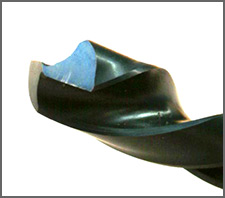Home | Glossary | Resources | Help | Contact Us | Course Map
Archival Notice
This is an archive page that is no longer being updated. It may contain outdated information and links may no longer function as originally intended.
Drilling is among the simplest of machining operations. Drilling by hand or machine power produces a hole, which may be the final result or the start of a subsequent operation. The drill bit is typically a rod with a sharp working edge at one end. Any cutting process produces residue. In machining, the residue is called chips that must be cleared so the tool will not bind. For metalworking drills, spiral cuts running up the drill shaft act as ramps to lift chips out of the hole so the drilling can continue.
Most drilled holes in firearms are of little concern to the firearm examiner. However, one is of critical concern to the examiner - the hole through the barrel of a handgun or rifle that marks a fired bullet. The deep hole drilling operations performed on rifled gun barrels form the foundation for the unique characteristics of each gun barrel that makes firearms identification possible.
This hole is drilled in practically all firearms made in the last 150 years. Deep-hole drilling is a challenging task that requires excellent tooling design and manufacturing techniques. Without such attention to detail, the hole will not be straight and the barrel may never shoot accurately.
A Permission is granted to copy, distribute and/or modify this document under the terms of the GNU Free Documentation License, Version 1.2 or any later version published by the Free Software Foundation; with no Invariant Sections, no Front-Cover Texts, and no Back-Cover Texts.
Additional Online Courses
- What Every First Responding Officer Should Know About DNA Evidence
- Collecting DNA Evidence at Property Crime Scenes
- DNA – A Prosecutor’s Practice Notebook
- Crime Scene and DNA Basics
- Laboratory Safety Programs
- DNA Amplification
- Population Genetics and Statistics
- Non-STR DNA Markers: SNPs, Y-STRs, LCN and mtDNA
- Firearms Examiner Training
- Forensic DNA Education for Law Enforcement Decisionmakers
- What Every Investigator and Evidence Technician Should Know About DNA Evidence
- Principles of Forensic DNA for Officers of the Court
- Law 101: Legal Guide for the Forensic Expert
- Laboratory Orientation and Testing of Body Fluids and Tissues
- DNA Extraction and Quantitation
- STR Data Analysis and Interpretation
- Communication Skills, Report Writing, and Courtroom Testimony
- Español for Law Enforcement
- Amplified DNA Product Separation for Forensic Analysts


